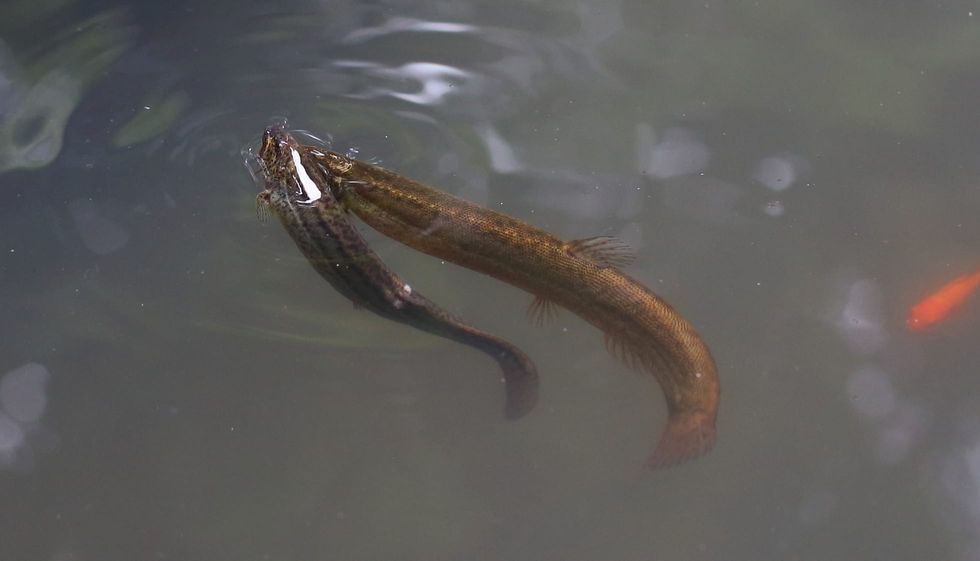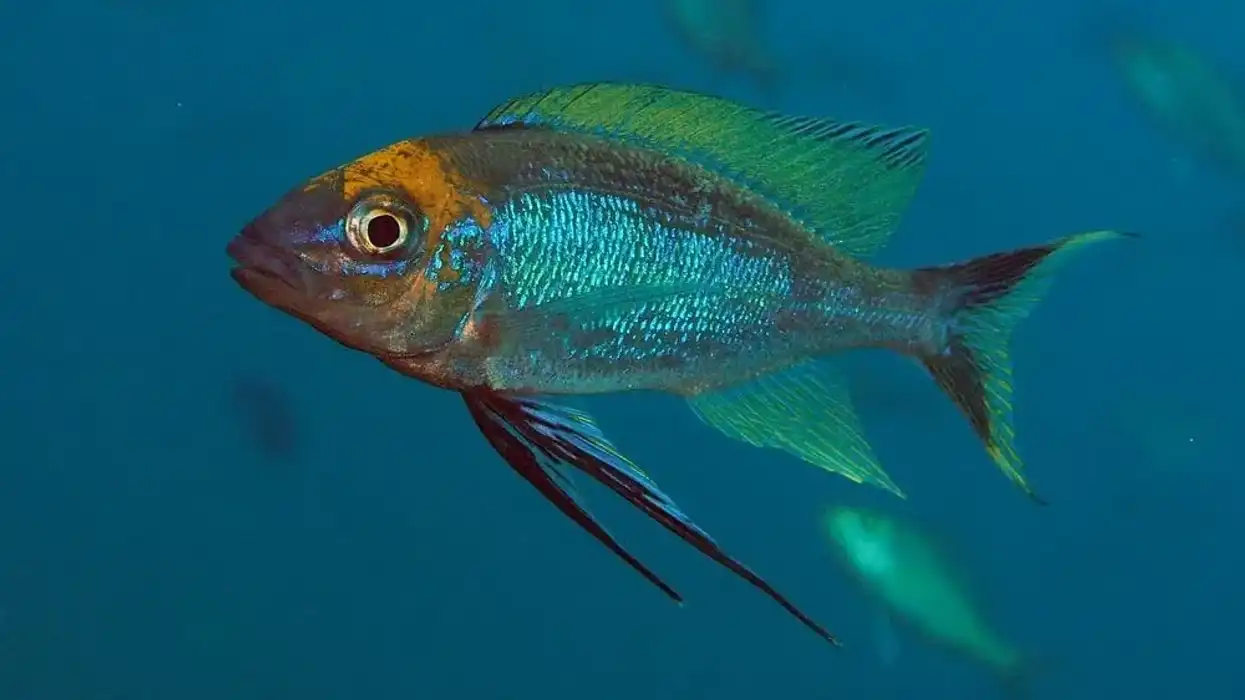Are you looking for some friendly fish to add to your pond? Then look no further than the pond loach!
These small fish are the perfect fish to keep in a tank, or in a home pond if you are fancy that way.
These eel-shaped fish work well with almost every other kind of fish, though you should think twice before you house them with smaller fish. Forever active, they can be aggressive only in their breeding season, when they need to be parted from their eggs in case they eat them.
This is a small, pale fish, and largely lacking in any bright colors, but its fast movements are bound to liven up your pond or tank. In fact, they come closer to the surfaces of water bodies during the early morning, so you just might be able to touch these small, yet pretty fish!
For now, you can read all about these beautiful swimmers, and maybe check out others like the beluga sturgeon and monkfish too!
Pond Loach Interesting Facts
What type of animal is a pond loach?
Misgurnus anguillicaudatus is a type of fish.
What class of animal does a pond loach belong to?
The pond loach belongs to the class of fish.
How many pond loaches are there in the world?
As these pond loaches are mostly aquarium fish, the population data of these freshwater fish is not available.
Where does a pond loach live?
The loach (Misgurnus Anguillicaudatus) lives in freshwater bodies in the wild and in aquariums in captivity.
What is a pond loach's habitat?
Pond loach fish like to reside in streams and rice paddy areas with a soft muddy substrate. Oxbows, backwaters, swamps, and paddy fields are popular habitats as are shallow, sluggish portions of rivers and streams, as well as quiet habitats like swamps, oxbows, backwaters, and rice fields.
Who does a pond loach live with?
These fish can be kept alone, but they do better and have more activity if maintained with other loaches in the tank water. With smaller fish, they may be violent, but most species with the same care requirements should be fine.
Pond loaches species are robust, active, and calm fish that are sometimes used for aquarium beginning fish. They show friendly behavior to humans, allowing for direct contact and feeding by hand. They are incredibly tranquil and goldfish get along quite well with them.
How long does a pond loach live?
The lifespan of a pond loach is between 7-10 years. Since lifespan is affected by various factors.
These loaches' lifespan may be longer than other types of loaches they are kept in very huge tanks with ideal water quality. Neon tetra fish can have a maximum lifespan of 10 years, but usually just two or three years in an aquarium.
How do they reproduce?
Breeding is not easy for this pond loach species. Breeding pond loaches necessitates several months of frigid temperatures. Seasonal fluctuations in the wild are simulated in this way.
In home aquariums, breeding frequently occurs by chance. For spawning, colder water temperatures may be required by these species. The female pond loach will usually lay up to 50 eggs at a single.
It's essential to keep the adults fish isolated from the fish eggs. Both males and females fish are capable of eating the eggs and show no parental behavior. The hatching time for fish eggs is only two to three days.
After hatching eggs, they can be feed infusoria for few weeks. Breeding of aquarium goldfish species following a large temperature change, which usually occurs in the spring. The majority of goldfish breeding is performed in captivity, especially in ponds.
What is their conservation status?
The conservation status of Misgurnus anguillicaudatus fish that is native to Asia is classified as of Least Concern by the IUCN Red List.
Pond loach Fun Facts
What does a pond loach look like?

They range in color from yellow to olive green, with paler undersides, to a typical light brown or grey. This tank fish features large and conspicuous pectoral fins, which can be used to distinguish males from female pond loach fish. Male pond loaches have larger pectoral fins than females. The female fish has a broader abdomen.
Three sets of barbels encircle the mouth of the loach. They are used to filter through silt or stones in search of food.
It also utilizes them to dig into sand and gravel to hide from predators or to hide from uneasiness. The pond loach, unlike many other fishes, can burrow into and conceal in soft surfaces, inhale air from the atmosphere if necessary, and survive for lengthy periods of time beyond the water.
How cute are they?
The Misgurnus anguillicaudatus species, native to Asia, have different vibrant body colors like yellow, olive green, light brown make them cute fish. There's also a golden variety of pond loach fish.
How do they communicate?
Communication skills information of these pond loach fish is not available because of less research done on this topic.
How big is a pond loach?
When fully grown in captivity, the ordinary pond loach measures no more than 6 in (15.24 cm) in length. These fish can grow up to about 12 in (30.48 cm) long in the wild. Angelfish can reach up to 6 in (15.24 cm) long. Pond loach fish lengths are quite similar to the Angelfish.
How fast can a pond loach swim?
The swimming speed data of pond loach fish (aquarium fish) is lacking due to the scarcity of research.
How much does a pond loach weigh?
The weight of the pond loach fish is around 0.16-3.84 oz (4.53-108.86 g).
What are the male and female names of the species?
The pond loach male and female don't have any special names.
What would you call a baby pond loach?
Babies of the pond loach fish don't have any specific names.
What do they eat?
Pond loaches are open to a wide variety of foods. The pond loach's favorite food is cooked peas, and its tank mates (like goldfish) can join in on the feast. Pond loaches in the wild mostly feed on organic materials like algae. They'll still rummage through the tank for a little algae diet.
If you're looking for a fast and easy approach to meet their nutritional requirements from the diet, dried pellets are a terrific choice. Most pond loach will not come towards the surface of the tank when there is a lot of other fish in the area, therefore sinking pellets are a necessity as their diet.
You can also use live or thawed foods to complement the dry food in the tank. Insect larvae and tubifex worms are among their favorite foods.
Tank species like the goldfish are omnivores that live in the wild and mostly feeding on insects, crustaceans, and plant matter food. Guppy fish, believe it or not, can go a week without eating in a fish tank.
Are they poisonous?
The freshwater pond loach belongs to the family Cobitidae and is not poisonous nor venomous to humans. These fish are nonaggressive, so there are no biting cases recorded by these species.
Would they make a good pet?
The pond loach is a fascinating fish that has been associated with humans for thousands of years, calling this one of the world's oldest 'domesticated' fish that is swimming in water on this planet.
They've subsequently been introduced to the tank business and have grown fairly popular since they scavenge on the bottom of the tank, which helps maintain it clean.
These pond loach fish are really calm. When they're threatened, they'll hide, but if they're at ease, they'll remain out in the open water into the tank.
When a bigger group of fish is present, these fish exhibit highly gregarious and playful behavior. With several other non-aggressive tank mates like Koi and goldfish, they will really show signs of sociability.
Whenever it comes to water temperatures, these fish are extremely tolerant. This quality makes them great tank fish.
One should make things easy for the fish in captivity, despite their toughness in harsh conditions. The water temperature in the tank should be between 65 - 75 °F (18°C- 24°C) to maintain a healthy environment.
Water temperatures range from 75 – 86 °F (24°C-30°C) for the Kuhli loach fish while the ideal temperature for the fancy goldfish is between 68 - 74 °F (20°C- 23°C).
These fish burrow through the substrate with their barbels in order to bury themselves. As a result, ensure the substrate is fine sufficient for this tank fish to dig. Granular sand can be used as a substrate.
To keep them healthy, pond loaches require a large tank. They enjoy swimming and exploring the tank's depths.
Smaller tanks will seem crowded and uncomfortable for this species because they can grow fairly lengthy. A pond loach should be kept in a 55-gallon (250 Ltr) tank at the very least. If you have plants in the tank, the loach fish will uproot them, therefore it's a smart option to weigh plants down.
Did you know...
The pond loach, native to the Asia region, has benefited humanity as an aquarium pet, as food, and aa a pond bottom feeder, yet it is most famous for its ability to anticipate the weather.
The name 'weather loach' refers to a fish's ability to identify changes in barometric pressure and react by frantically swimming or stationary for long periods of time. It is because barometric pressure changes before the storm, which is known for making these Oriental weatherfish highly active.
These loaches can survive for several hours without water. These fish protect themselves by secreting a mucous layer around their body.
If they are spotted dried up, they may still be reintroduced into the tank, and these fishes are usually back up and running in no time. The water inside the tank in which the loaches are kept should be kept cool at all times and must never be warmed.
In the wild, the golden pond loaches' max size is almost 12 inches long.
Golden weather loaches will hide inside the sands until things improve, at which point they will emerge from their 'hibernation'.
Are loaches edible?
This variety of loach fish can be eaten and has been used in soups in Korea and Japan, but it may also be reared in an aquarium. Japanese loach is a delicious dish made from loach fish.
Can loaches live in ponds?
Weather loaches are low-maintenance, long-lived fish that can live up to 10 years. They enjoy cold freshwater, making weather loach in pond ideal for ponds in our backyards. They're a great choice for water gardens, private ponds, and aquariums because of their versatility.
Here at Kidadl, we have carefully created lots of interesting family-friendly animal facts for everyone to discover! Learn more about some other fish from our Tarpon facts and Bonito fish facts pages.
You can even occupy yourself at home by coloring in one of our free printable pond loach coloring pages.










